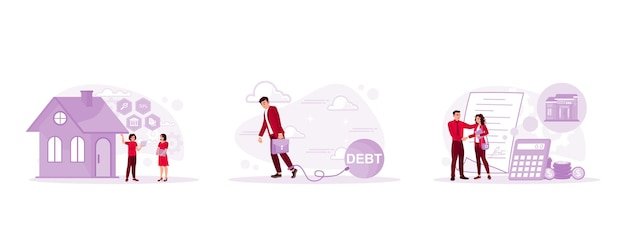Understanding US Student Loan Forgiveness Programs in 2025
Understanding US Student Loan Forgiveness Programs in 2025 involves navigating various federal initiatives like Public Service Loan Forgiveness (PSLF), Income-Driven Repayment (IDR) plans, and potential future legislative changes, each offering unique eligibility criteria and application processes for borrowers seeking debt relief.
Navigating the complex landscape of US student loan forgiveness programs can feel overwhelming. With potential changes on the horizon in 2025, it’s crucial to understand the existing options and how they might evolve. This article will provide a comprehensive overview of the key US Student Loan Forgiveness Programs in 2025, helping you determine your eligibility and the best path forward.
Understanding the Landscape of Student Loan Forgiveness
The pursuit of higher education often comes with a significant financial burden in the form of student loans. Recognizing this challenge, the US government offers various student loan forgiveness programs. These programs aim to alleviate debt for borrowers who meet specific criteria, such as working in public service or adhering to income-driven repayment plans. Understanding these programs is essential for anyone burdened with student loan debt.
Federal Student Loan Forgiveness Programs Overview
Several federal programs offer student loan forgiveness, each with its own requirements and benefits. The most prominent include Public Service Loan Forgiveness (PSLF) and Income-Driven Repayment (IDR) plans. These initiatives seek to make student loan repayment more manageable and provide eventual forgiveness under certain conditions.

Key Considerations for 2025
As we move into 2025, several factors could influence student loan forgiveness programs. Potential legislative changes, economic conditions, and policy adjustments by the Department of Education all play a role. Staying informed about these developments is key to maximizing your chances of benefiting from forgiveness.
- Legislative Updates: Keep an eye on any proposed bills that could impact eligibility criteria or program funding.
- Economic Factors: Economic downturns could lead to temporary expansions or modifications of existing programs.
- Department of Education Policies: The Department of Education can adjust regulations and guidelines related to student loan forgiveness.
Understanding the current state of student loan forgiveness, combined with awareness of potential changes, empowers borrowers to make informed decisions about their repayment strategies and eligibility for debt relief.
Public Service Loan Forgiveness (PSLF)
The Public Service Loan Forgiveness (PSLF) program is designed to forgive the remaining balance on Direct Loans after 120 qualifying payments made while working full-time for a qualifying employer. This program provides an opportunity for those dedicated to public service to receive significant debt relief.
Eligibility Criteria for PSLF
To be eligible for PSLF, borrowers must meet several key requirements. These include working full-time for a qualifying employer, having Direct Loans (or consolidating other federal student loans into a Direct Loan), and making 120 qualifying payments under a qualifying repayment plan.
Qualifying employers include government organizations at any level (federal, state, local, or tribal) and certain non-profit organizations that are tax-exempt under Section 501(c)(3) of the Internal Revenue Code. Certain other types of non-profit organizations may also qualify if they provide specific types of public services.
Navigating the PSLF Application Process
The PSLF application process involves several steps, including submitting an Employment Certification Form (ECF) annually or whenever you change employers. This form verifies that your employment qualifies for the program. After making 120 qualifying payments, you must submit the PSLF application to have your remaining loan balance forgiven.
- Submit the ECF Regularly: Ensure your employment is certified annually to track qualifying employment periods.
- Keep Detailed Records: Maintain thorough records of your employment, loan payments, and any communication with loan servicers.
- Apply for PSLF After 120 Qualifying Payments: Once you’ve made the required payments, submit the official PSLF application.
The PSLF program offers a substantial benefit for those working in public service. By understanding and meeting the eligibility criteria and carefully navigating the application process, borrowers can potentially have their remaining student loan debt forgiven.
Income-Driven Repayment (IDR) Plans
Income-Driven Repayment (IDR) plans are designed to make student loan repayment more affordable by basing monthly payments on your income and family size. These plans offer an alternative to standard repayment plans and can lead to loan forgiveness after a specified repayment period.
How IDR Plans Work
IDR plans calculate your monthly payment based on a percentage of your discretionary income. The most common IDR plans include Income-Based Repayment (IBR), Pay As You Earn (PAYE), Saving on a Valuable Education (SAVE), and Income-Contingent Repayment (ICR). Each plan has its own eligibility requirements and repayment terms.
Loan Forgiveness Under IDR Plans
Under IDR plans, any remaining loan balance is forgiven after a specified repayment period, typically 20 or 25 years, depending on the plan. The amount forgiven may be subject to income tax, depending on current tax laws.

Key aspects of loan forgiveness under IDR plans:
- Repayment Period: Understand the length of the repayment period required for forgiveness under your specific IDR plan.
- Tax Implications: Be aware of potential tax liabilities on the forgiven amount.
- Annual Recertification: Recertify your income and family size annually to ensure accurate monthly payments.
IDR plans provide a flexible and potentially forgiving repayment option for borrowers struggling to afford their student loan payments. Understanding the specifics of each plan and staying on top of income recertification are crucial for maximizing the benefits of IDR program forgiveness.
New Developments and Potential Changes in 2025
The landscape of student loan forgiveness is subject to change due to legislative actions, policy adjustments, and economic factors. Staying informed about potential changes in 2025 is essential for borrowers seeking to maximize their eligibility for forgiveness programs.
Legislative Initiatives
Congress may introduce new legislation that impacts student loan forgiveness programs. It’s important to monitor proposed bills and understand how they might affect eligibility criteria, funding levels, and program rules.
Policy Adjustments by the Department of Education
The Department of Education has the authority to make regulatory changes to existing student loan programs. These adjustments can impact various aspects, including eligibility requirements, application processes, and loan servicing practices.
Follow these to stay informed:
- Official Announcements: Regularly check the Department of Education’s website for official announcements and updates.
- Reputable News Sources: Stay informed through reputable news outlets that cover education policy and student loan issues.
- Financial Advisors: Consult with financial advisors who specialize in student loan planning to receive personalized guidance.
Remaining vigilant and adaptable to new developments in 2025 will empower student loan borrowers to navigate the evolving landscape and optimize their chances of receiving debt relief through available forgiveness programs.
Strategies for Maximizing Forgiveness Eligibility
To increase your chances of qualifying for student loan forgiveness, it’s essential to implement proactive strategies focused on meeting eligibility requirements and optimizing your financial situation. Effective planning can make a significant difference in your ability to receive debt relief.
Choosing the Right Repayment Plan
Selecting the most appropriate repayment plan is a critical step. Evaluate your income, family size, and long-term financial goals to determine whether an IDR plan or another type of repayment plan is best suited to your needs.
Employment Certification and Documentation
For those pursuing PSLF, consistent employment certification and thorough documentation are crucial. Submit the Employment Certification Form (ECF) annually or whenever you change employers to ensure your qualifying employment is properly tracked. Also, keep detailed records of loan payments and communications with loan servicers.
Consider these valuable things:
- Annual ECF Submission: Certify your employment annually to maintain accurate records.
- Detailed Record Keeping: Keep copies of all loan-related documents and correspondence.
- Financial Health Check-ups: Periodically review your overall financial health with a professional to ensure eligibility.
Maximizing your eligibility for student loan forgiveness requires careful planning, proactive management, and a thorough understanding of program requirements. Implementing these strategies can significantly improve your chances of receiving debt relief.
Common Mistakes to Avoid
Navigating student loan forgiveness programs can be complex, and making mistakes can jeopardize your eligibility and delay the debt relief process. Avoiding common pitfalls is essential for successfully obtaining forgiveness.
Misunderstanding Eligibility Requirements
A common mistake is failing to fully understand the eligibility requirements for PSLF or IDR plans. Carefully review the criteria for each program and ensure you meet all necessary conditions, such as qualifying employment or income thresholds.
Inaccurate or Incomplete Applications
Submitting inaccurate or incomplete applications can cause significant delays. Double-check all information before submitting your application, and ensure you provide all required documentation.
Common mistakes include:
- Missing Deadlines: Stay aware of all application deadlines and submit your paperwork on time.
- Incorrect Documentation: Ensure your supporting documents are accurate and up-to-date.
- Lack of Follow-Up: After submitting your application, follow up with your loan servicer to confirm receipt and address any questions or concerns.
By being diligent, informed, and proactive, you can avoid these common mistakes and increase your chances of successfully obtaining student loan forgiveness.
| Key Point | Brief Description |
|---|---|
| 💼 PSLF Eligibility | Working full-time for a qualifying employer while making 120 qualifying payments. |
| 💰 Income-Driven Repayment | Plans that base monthly payments on income and family size, with forgiveness after a set period. |
| 📅 Legislative Changes | Staying updated on potential legislative initiatives affecting forgiveness programs in 2025. |
| 📝 Application Mistakes | Avoiding errors in applications by understanding eligibility and providing accurate documentation. |
Frequently Asked Questions
▼
PSLF forgives the remaining balance on Direct Loans after 120 qualifying payments made while working full-time for a qualifying employer, such as government or non-profit organizations.
▼
IDR plans base your monthly student loan payments on your income and family size. After a set period of repayment (20-25 years, depending on the plan), the remaining balance is forgiven.
▼
You should submit an Employment Certification Form (ECF) annually or whenever you change employers. This form verifies that your employment qualifies for the PSLF program.
▼
The tax implications of student loan forgiveness can vary. Under current law, amounts forgiven under IDR plans may be subject to income tax, but this could change with future legislation.
▼
Monitor the Department of Education’s website, follow reputable news sources covering education policy, and consult with financial advisors who specialize in student loan planning for the latest updates.
Conclusion
Understanding the intricacies of US student loan forgiveness programs in 2025 is crucial for borrowers seeking debt relief. By staying informed about available options, eligibility criteria, potential changes, and common pitfalls, you can strategically navigate the landscape and maximize your chances of achieving financial freedom from student loan debt.





